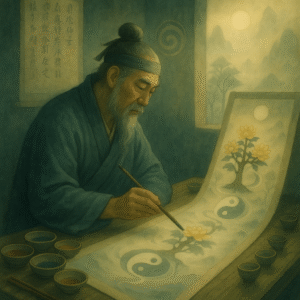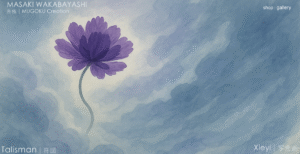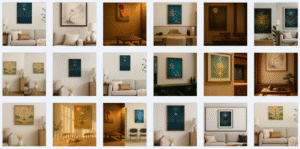Xieyi painting as talismanic imagery
Reviving Sacred Diagrams: Xieyi as Contemporary Conceptual Art
This artist revives the ancient tradition of 符図 (fú tú)—talismanic diagrams—and reimagines it through the lens of contemporary conceptual art. Using the spontaneous language of Xieyi freehand brushwork, each painting becomes more than visual beauty; it becomes a living structure of energy, symbolism, and intention.
These works are not designed for passive viewing. They function as energetic anchors, balancing space and mind, much like Daoist diagrams once did for temples and healing halls. But now, they return—not as relics of the past, but as contemporary visual systems, responsive to the spiritual needs of the present.
The controlled unrestrainedness of the drawings and the serenity imbued in the expression touch the viewer’s depths, intuitively speaking to the movement of chi, the laws of yin and yang, and the geometry of the soul.
 A talisman. A painting. A code of presence.
A talisman. A painting. A code of presence.
This is Xieyi reborn—as art that acts.
A code of presence—hidden message / cipher
Not written in words, but drawn in breath and motion.
It is the silent rhythm beneath the brushstroke,
The invisible order that shapes the stillness.
Like a compass that points inward,
It marks the place where spirit enters space—
Where art becomes not just seen, but felt.
Xieyi Painting – The Art of Expressing Spirit over Form
Rather than copying the appearance of nature, Xieyi seeks to capture its inner life and feeling—the energy of a flower blooming, the spirit of a mountain, or the breath of the wind.
Xieyi painting is not just about what you see, but what you feel.
“Unlike realistic painting, Xieyi is not about imitation—it is about revelation. It reveals the soul of the subject, and the heart of the painter.”
Xieyi Painting as a Talismanic Diagram – A Visual Expression of Energy and Spirit
Xieyi painting, when created as a “talismanic diagram” (符図 / fú tú), goes beyond artistic beauty.
It becomes a sacred symbol—a visual vessel that holds and transmits energy (qi), intention, and spiritual resonance.
Unlike decorative art, such works are not merely for viewing, but are meant to align space, mind, and spirit. Each brushstroke is imbued with meaning, vibration, and consciousness, reflecting Dao cosmology, natural law, and inner cultivation.
These paintings function like visual mantras or energetic maps, guiding the viewer toward harmony, vitality, and insight.
They are not just paintings—they are living symbols.
Xieyi Painting – Expressing the Workings of the Heart
A One-of-a-Kind Existence
It serves to capture a fleeting inner essence that would otherwise vanish, making each work a one-of-a-kind existence in the world.
“Xieyi” (写意) means to give form to the intangible. When an intention is painted, that essence is transferred onto the canvas, and within the painting, an entire world comes to life.
What Is Xieyi? — The Soul of Eastern Art: “Expressing the Spirit”

Linguistically, “xie” means “to depict” or “to copy,” while “yi” refers to the essence of the mind and spirit. Thus, the principle is “to depict not the form, but the intention.”
The purpose of xieyi is not mere visual reproduction, but the expression of *qi yun* (the rhythm of life-energy), spirit, and inspiration—the living presence that a subject contains.
This stands in contrast to Western realism, which emphasizes faithful reproduction of physical form. In xieyi, the visible form becomes a medium through which the state of the heart is conveyed.
Affinity with Daoist Thought — Harmony with *Wu Wei Zi Ran*
In particular, the Daoist ideal of *wu wei zi ran* (無為自然, “non-action and naturalness”)—a life free from artificial contrivance and in harmony with nature—resonates with the brushwork of xieyi, which flows without attachment to rigid form.
Painting is not an exhibition of technical skill, but an unfolding of *qi* (energy flow) and the manifestation of intention.
Rather than clinging to external shapes, the focus lies in how the intended spirit arises within the current of *qi* upon the canvas. Here, the Daoist sensibility of “formless yet existent, empty yet real” is alive.
Talismanic Diagrams and Xieyi — A Spiritual Art of Visualization
Though often serving as talismans, they can also be regarded as spiritual paintings created through xieyi-like expression.
*Fu tu* do not depict physical shapes but symbolize concepts, spiritual forces, and cosmic laws. In this sense, they represent the highest form of xieyi.
The vigor and flow of the brushstroke infuse them with power that directly resonates with the viewer’s spirit, functioning as art that evokes a spiritual response.
For centuries, people have placed Daoist xieyi paintings and talismanic diagrams in their homes, studies, or bedrooms, seeking blessings of longevity, health, harmony, and good fortune.
To view such art was not only to appreciate beauty but to invite the presence of the Dao into daily life, attuning both body and mind.
The Power of Xieyi Painting: Connecting Spirit and Daily Life
• It visualizes *qi* (life-energy),
• Gives form to the formless,
• Accepts nature as it is,
• And inscribes the state of the heart upon the surface of the painting.
Above all, it has been embraced as a way to integrate Daoist living and the flow of energy into everyday spaces.
Xieyi: Not “What the Eyes See,” but “What the Heart Feels”
Both talismanic diagrams and xieyi paintings continue to live on as “sacred paintings that speak to the human soul,” from ancient times to the present.







